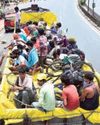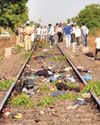
In June 2006, a trial court in Baikunthpur in BAIKUNTHpur in Chhattisgarh handed out the death penalty to 18-year-old Sonu Sardar on charges of dacoity and murder. Of the gang of five persons who were accused of the crime, one was a juvenile and the other three are still absconding. The fact that Sonu Sardar was only 18 years and two months old when he committed the offence could have served as a mitigating factor to reduce his sentence. But this important fact only came to light in 2014, eight years after he was sentenced by the trial court. A group of student researchers at the Death Penalty Research Project of the National Law University Delhi (NLUD), in collaboration with the National Legal Services Authority, discovered this vital information during a field trip to the panchayat office of Sonu Sardar’s village. The project, conceptualised in June 2013, aimed to collate data about prisoners on death row across States vis-a-vis their level of access to legal representation, experience with the trial courts, life in prison and the socio-economic profile. About 90 student researchers were engaged in this project. Throughout the proceedings in the trial court and later on in the High Court and the Supreme Court, Sonu Sardar’s age was erroneously mentioned as 23. It was only in a review petition filed in the Supreme Court in 2015 that this fact was brought to light.
Diese Geschichte stammt aus der August 21, 2015-Ausgabe von FRONTLINE.
Starten Sie Ihre 7-tägige kostenlose Testversion von Magzter GOLD, um auf Tausende kuratierte Premium-Storys sowie über 8.000 Zeitschriften und Zeitungen zuzugreifen.
Bereits Abonnent ? Anmelden
Diese Geschichte stammt aus der August 21, 2015-Ausgabe von FRONTLINE.
Starten Sie Ihre 7-tägige kostenlose Testversion von Magzter GOLD, um auf Tausende kuratierte Premium-Storys sowie über 8.000 Zeitschriften und Zeitungen zuzugreifen.
Bereits Abonnent? Anmelden

How Not To Handle An Epidemic
The lockdowns were meant to buy time to put in place appropriate health measures and contain the coronavirus’ spread, but they have failed to achieve the objective and heaped immense misery on the marginalised sections of society. India is still in the exponential phase of the COVID-19 infection and community transmission is a reality that the government refuses to accept.

Tragedy on foot
As the COVID-19-induced lockdown cuts the ground beneath their feet in Tamil Nadu, thousands of migrant workers are trudging along the highway to the relative safety of their upcountry homes.

Sarpanchs as game changers
Odisha manages to keep COVID-19 well under control because of the strong participation of panchayati raj institutions and the community at the grass-roots level under the leadership of Chief Minister Naveen Patnaik.

Scapegoating China
As the COVID-19 death rate spikes and the economy tanks in the United States, Donald Trump and his advisers target China and the World Health Organisation with an eye to winning the forthcoming presidential election.

New worries
Kerala’s measured approach to the pandemic and lockdown has yielded results. But it still has to grapple with their huge economic impact on its economy, which it feels the Centre’s special financial relief package does little to alleviate.
No love lost for labour
Taking advantage of the lockdown and the inability of workers to organise protests, many State governments introduce sweeping changes to labour laws to the detriment of workers on the pretext of reviving production and boosting the economy.

Capital's Malthusian moment
In a world that needs substantial reorienting of production and distribution, Indian capital is resorting to a militant form of moribund neoliberalism to overcome its current crisis. In this pursuit of profit, it is ready and willing to throw into mortal peril millions whom it adjudicates as not worth their means—an admixture of social Darwinism born of capital’s avarice and brutalism spawned by Hindutva. .

Understanding migration
When governments and their plans are found to be blatantly wanting in addressing reverse migration, exercises such as the Ekta Parishad’s survey of migrant workers throughout India can be useful to work out creative long-lasting solutions.

Waiting for Jabalpur moment
The Supreme Court’s role in ensuring executive accountability during the ongoing lockdown leaves much to be desired. Standing in shining contrast is the record of some High Courts.

An empty package
The Modi regime, which has been unable to control the COVID-19 infection, restore economic activity and provide relief to millions exposed to starvation, trains its sights on Indian democracy, making use of the panic generated by fear and a lockdown that forecloses paths of resistance.